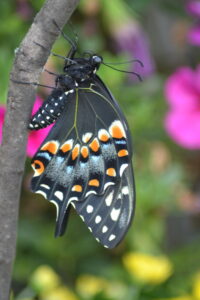The uniquely beautiful golden tamarack

Karen Wils photo Two beagles by a tiny tamarack tree.
ESCANABA — Let the yellow and the gold shine! It’s tamarack time!
Upper Michigan is in its late stage of autumn color. That means it’s time for the oaks, aspen and tamaracks to light up the woodlands.
Of these three, the tamarack tree is my favorite. They dress up for Halloween.
From lush green triangles on the horizon, they transform into a spicy amber color just in time for Halloween.
Tamaracks are the only conifer (cone bearing) tree in Michigan that sheds its needles every autumn. So by All Saint’s Day (Nov. 1) and by All Soul’s Day (Nov. 2), the tamaracks look dead.
Often the tamarack’s needles fall onto the wet ground that this “larch” tree thrives in. Swampy puddles become” yellow brick roads “with golden needles floating on the water.
But, fear not, come spring soft, supple pale green needles will once again sprout on the tamarack’s branches.
Even though the maples and birches have lost most of their leaves by now, it is still worth a ride in the country to see the mellow yellows of the quaking aspens and the tamarack trees.
Tamaracks are native to Michigan soils. They like moist conditions and grow healthy and strong around ponds, lakes and rivers. It’s true they are not much good for Christmas trees but tamaracks have been very important to the economy of the North Country.
Nick named “the 100 year post” tamarack wood is strong and very slow to decay. Many of the beams in the damp underground mines of the U.P. were made of tamarack wood. Pilings driven deep into the lakes to make docks for boats were made of tamarack wood. And even the beams in my father-in-law’s barn were weathered, well-worn tamarack wood.
A tamarack is a pretty tree in the spring when its wispy needles fluff out in neat bundles. Then it grows the daintiest pinkish cones. But in late October, the tamarack simply glows!
My love for this tree goes way, way back to my younger days when I was single. I had purchased some wooded property near our family’s camp. Shortly after I bought it, my dad hiked the entire place with me, admiring each tree and sign of wildlife. We took a break on the edge of a ridge and Dad said “and look, you even have two nice tamaracks.”
That is how my place on the river got its name and my kennel of beagles became known as Two Tamaracks Hounds.
Snowshoe hares and deer love to eat the young sapling tamarack trees. Red squirrels and birds feast on the tamarack’s cones and large birds like ospreys and owls often use the tops of tamaracks to build nests in.
Tamaracks in October are awesome markers of time. Find a golden tamarack near you and take a moment just to quietly sit by it and recall all the joy of the growing season.
——
Karen (Rose) Wils is a lifelong north Escanaba resident. Her folksy columns appear weekly in Lifestyles.



